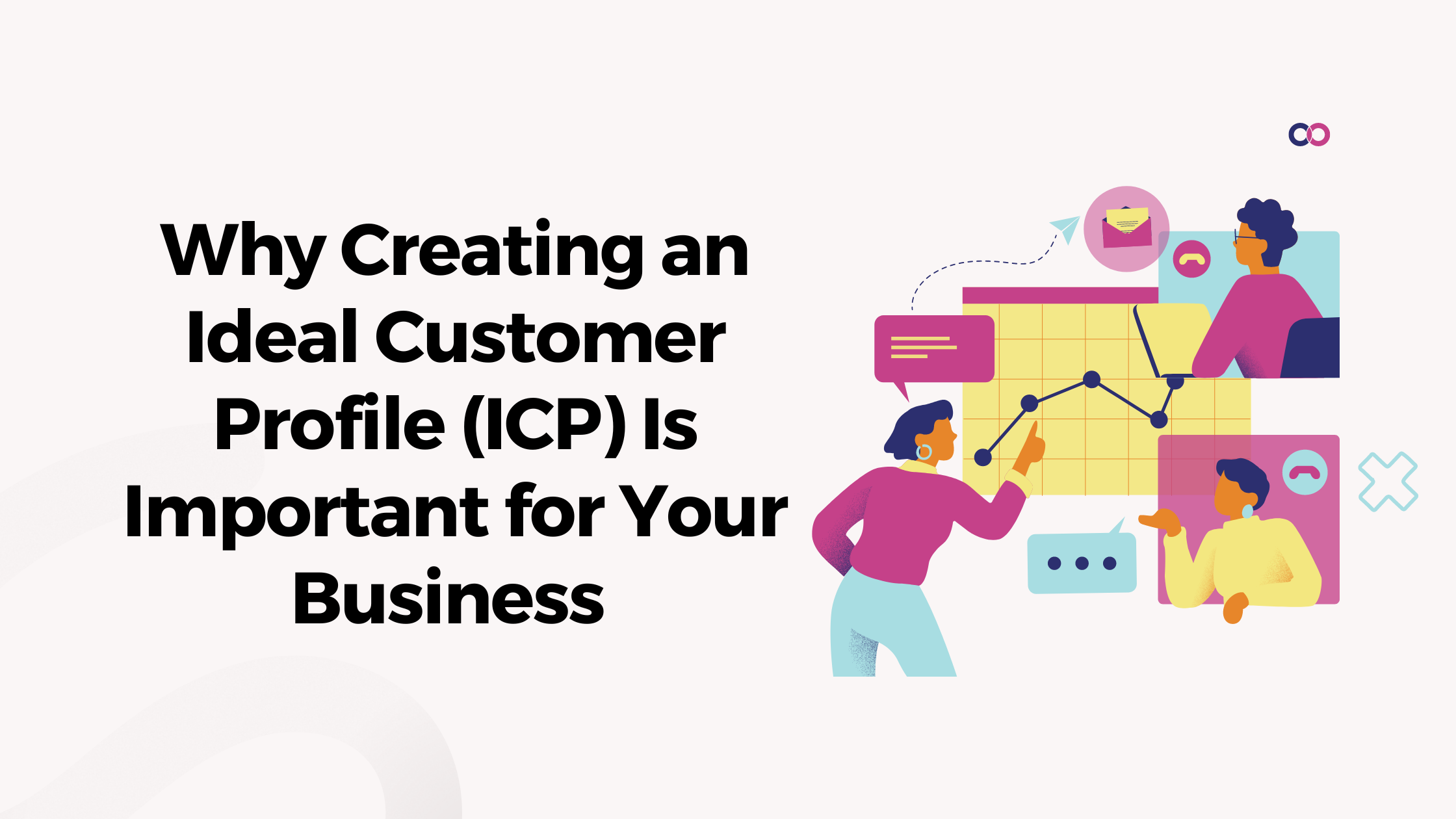In today’s business world, it takes a lot of concerted effort to stand out from the pack.
With each passing year, more companies and corporations enter the marketplace, so fine-tuning your marketing strategy, identifying your best customers (things like their demographics, pain points, etc.) amongst your current customers, and finding out who your target customers are all help you differentiate yourself from your competition.
How do you accomplish all this? The answer is simple—employing an ideal customer profile, or ICP for short. In this article, we’ll walk you through
- What an ICP is
- Traits to look out for
- Why it’s your best customer base compared to other alternatives
- Core ICP components
- List a step-by-step process to identify your ICP.
What is an Ideal Customer Profile?
An ICP is a detailed description of the perfect company, corporation, or customer whose business you want to earn. Essentially, it helps you identify who your target audience is. ICPs are very important in B2B (business-to-business) marketing and to B2B companies. They play a key role in the sales cycle for any sales team, speeding up how quickly new business is earned.
Ideal Customer Traits
If you’ve asked yourself, “What sorts of qualities should I look for in an ideal customer,” you aren’t alone. Knowing what traits to look for is exhausting at times. The following are six characteristics worthy of consideration.
- Industry fit: the industry they’re involved in makes sense for your product or service.
- Profitability: potential customers have the budget to buy your offerings AND continually use those offerings.
- Ready to buy: you’re confident your company can solve the pain points potential customers encounter, addressing their needs in the process.
- Growth potential: buyers demonstrate the ability to scale their company.
- Size: The company headcount total aligns with what you can handle. Nothing too big or too small.
- Geographical fit: buyers are located in a geographical location that makes sense to sell to.
Importance of ICP
Ideal customer profiles are important to your business because, point blank, it’s one of the easiest ways to create a marketing plan without needing to assemble a large marketing team (although there’s no one stopping you from doing so if you please).
When done right, ICPs become an automated lead generation system, bringing plenty of ideal buyers for your product or service into your company’s spotlight—all while improving customer retention rates and new client conversion rates. If you want to develop a marketing scheme, those efforts won’t be in vain. Additionally, knowing where your company benefits the most helps dictate who you sell to. Selling to every customer and company interested in your offerings isn’t a bad strategy, but it leads to high customer churn rates—or customers who ultimately decide to stop using what you sell. ICPs help you get laser-specific information about who to target and why.
So, what goes into an ICP?
Components of an ICP
Most ICPs are comprised of several sections, including but not limited to behavior patterns, demographics, needs and pain points, and psychographics.
Behavior Patterns
Behavior patterns refer to the way(s) consumers interact with your product, service, or brand. It includes brand loyalty, buying habits, preferred communication channels (email, text, etc.), and how they use the products or services. The more you understand consumer behavior patterns, the more strategic you can be.
Demographics
Demographics are all the traits and stats related to a customer. It includes their age, education level, gender, income, location, and job title/occupation. In B2B marketing, demographics include company size, industry, and job role, all of which are important when determining what your sales and marketing strategy includes.
Needs and Pain Points
What sorts of issues do customers face? What challenges do they encounter when using similar products or services? How do competitors address problems, and do their offerings alleviate the client’s concerns? Questions like these play a vital role in uncovering needs and pain points for ICPs. When done right, the products and services you offer will remedy the problems consumers face. As a result, you’ll be able to create better marketing and sales offerings, enhancing the overall customer experience.
Psychographics
Psychographics study and categorize people based on various psychological criteria. They help you identify the type of customer most likely to align with your company. Psychographics include attitudes, interests, lifestyles, traits, and values, offering valuable insight into the inner workings of prospective consumers. Companies use this info to shape content, engagement, and messaging strategies.
ICP vs. Buyer Persona
A buyer persona is a holistic representation of the person most likely to buy your product or service. It includes their demographics, goals and motivations, pain points, common objections, and interests. Buyer personas differ from ICPs in one major way—they usually require people who need to be involved in the companies’ purchasing decisions. After all, when it comes to finances, they’re the decision-makers. Also, ICPs are used to build buyer personas.
ICP vs. Target Customer
A target customer is any person or organization you hope to sell your product or service to. Put together, your target customers contribute to your customer base. Conversely, ICPs are THE best customers for your target customers. They engage with you the most, like your products, and buy them regularly.
ICP vs. Target Market
Target markets are usually used in B2C (business-to-consumer) fields. Instead of focusing on one consumer, target markets focus on a core group of like-minded consumers who stand to benefit from your product or service.
Creating Your ICP
Step 1: Make a list of your best current customers
Go through your current customer roster. Identify your top 10 clients. Use whatever criteria you feel comfortable with when listing them out. Focal points like how much they spend, their levels of engagement, the value they get from your offerings, etc., are all important.
Some companies refer to how much clients spend as customer lifetime value, a fancy way to describe revenue. Other businesses highlight customer service costs, or how much it costs to service a specific customer.
Others pay special attention to referrals, or the amount of business current customers bring in, and sales cycle length, the amount of time it takes to complete a sale. Regardless of what you choose to concentrate on, make sure it fully represents your best clients.
If you have difficulty finding this information, using a customer relationship management, or CRM platform, makes a world of difference. CRMs impact how companies interact with customers directly, studying large amounts of customer data to dictate policy and direction.
Step 2: Identify core customer attributes
Figuring out the core attributes of your ideal consumer is helpful in shaping your ideal customer profile. You can derive most of these attributes from their demographics – things like age and location. Psychographics, or their attitudes, interests, values, etc., are also part of the equation. List out as many positive traits as you can think of.
When combined, these areas of emphasis help you identify the preferences of the buyer persona in your target market. As a result, marketing your products or services to them resonates on a deeper, more profound level.
Step 3: Prioritize attributes of ideal customers
After laying out the core attributes of ideal customers, it’s time to trim that list. Highlight the top five to ten qualities that make up your ideal potential customers. The reason condensing this list is so important is because it provides the necessary clarity.
The longer your list, the harder it is to pinpoint the characteristics you truly value. Put another way, have you ever struggled to find something to watch on a streaming service like Netflix? The more options you’re presented with, the more challenging narrowing your options down becomes.
But the more individualized those choices, the more likely you are to make a selection without giving into anxiety or feelings of dread. Keep this in mind when prioritizing qualities.
Step 4: Learn more about your best customers
Once you’ve figured out the core attributes of your ideal consumers, you can learn even more about them in two ways—by conducting interviews and doing a demographic deep dive.
Conducting interviews is a great way to gain additional relevant customer information that can’t be gleaned from data alone. You want to obtain as much insight into their decision-making process and how they feel about your product or service as possible.
The best way to conduct interviews is with a video conference platform like Zoom, Skype, or Microsoft Teams. Aim to uncover the customer’s emotional response to your offering and company. Phone calls or emails work but should be considered secondary options. Ask open-ended questions to get the best response out of them; yes or no questions don’t take much effort.
Use a CRM platform to do a deep dive into hard data related to customers. Focus on company size, funding, growth trends, industry, location, revenue, and tools, amongst others. Use this info to build a behavioral profile of your ideal customer, grouping similar individuals with individuals and companies with companies.
Final Thoughts
There are several noteworthy components of an ideal customer profile. While no two companies agree on everything, an ICP should include, most understand why they’re important. Creating an ICP is more than a marketing strategy; it’s a blueprint to customer success and part of a modern-day approach to business operations.
Here’s the bottom line—ICPs are incredibly valuable tools for all organizations, regardless of the type of company you run. It provides enhanced visibility into why your best customers choose your offerings, the problem(s) you solve for them, and any vital characteristics they share with others.
Those insights are useful for the entire company and any key stakeholders, not just members of the sales team or those in marketing-related roles. When you create a comprehensive ICP, your business becomes better at attracting, satiating, and retaining customers.
Click here to check out our Thought Leadership 101 guide.


